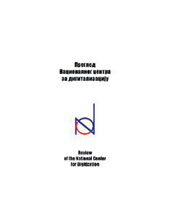Issues
Review of the National Center for Digitization
Publisher: Faculty of Mathematics, University of Belgrade
ISSN: 1820-0109
Issue: 26
Year: 2015

Preface
Zoran Ognjanović
1 - 1
Tradition and Innovation in the Cendari Research Infrastructure
Jennifer Edmond
Keywords: research infrastructure; transnational history; digital humanities
2 - 9
Cosch - Towards a Better Common Understanding in Cultural Heritage Documentation
Frank Boochs
Keywords: cultural Heritage documentation; optical technologies; 3D scanning; multispectral imaging; colour
10 - 17
The Most Searched for Items in Elibrary
Nikolina Vukša Popović and Žarko Mijajlović
Keywords: digital repository; search engine; Google
18 - 26
A Manuscript on Astronomy and Geodesy of an Unknown Author
Nadežda Pejović and Slobodan Ninković
27 - 36
Safeguarding the Musical Heritage.Sounds of the Past: a Digitization Project of the National and University Library in Zagreb
Tatjana Mihalić
Keywords: musical heritage; historical sound recordings; gramophone records on 78 rpm; digitization project; sound digitization; sound restoration
37 - 46
Open Source Folklore Archives - Disseminating Small Memory Boxes
Liviu Pop
Keywords: open source folklore archive; cultural heritage; digital archives; intangible culture; Romanian folklore
47 - 52
Virtual Exhibition As a Medium for Presenting Scientific and Cultural Heritage to International Audiences: Đorđe Stanojević - a Rector Who Lit Up Belgrade
Ljubica Ćorović, Vesna Vuksan and Adam Sofronijević
Keywords: virtual exhibition; heritage; culture; Djordje Stanojević; University library Belgrade; Serbia
53 - 61
Geometric Investigation of Large 3D Spatial Data for Virtual Museum Applications
Bata Vasić, Igor Antolović and Dejan Rančić
Keywords: 3D geometry; 3D modeling; 3D scanning; cultural heritage; digital archive; virtual musem
62 - 68
Scientific Papers of Milutin Milanković in His Digital Legacy
Nadežda Pejović, Saša Malkov, Nenad Mitić and Žarko Mijajlović
69 - 76
Newspapers in the National and University Library in Slovenia - Access Model
Irena Eiselt
Keywords: serials; contemporary newspapers; historical newspapers; microfilming; digital copies; access model
77 - 85
The Virtual Deposit Library – Introduction of the Project and the First Results
Tomáš Foltýn and Anna Vandasová
Keywords: Key words: deposit library; preservation collections; legal deposit; enrichment of the book collections
86 - 93
95 - 96